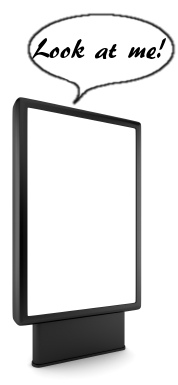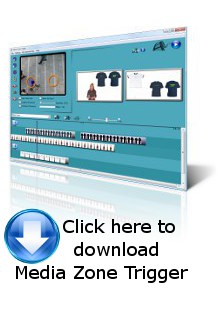|
Why
care about interactive
displays?
Like most folks, I walk right by most printed advertising, hardly
noticing it anymore. Static posters are part of the landscape. Digital
signage is coming around... I'll certainly take a look at something
that is moving, but it will be a skeptical look. If I know I'm being sold
something, they had better make it good if they want to have a few
seconds of my time. Entertain me, surprise me, make it quick.

Arriving in the middle of a video
provides a less than ideal viewing
experience, wouldn't it be awesome if the video started just as I
approached? What if the video called me at that moment? What if this
video was itself interactive, would it convert more viewers? Would it
deliver a more personal experience?
The Media Zone Trigger
software
I
started hearing those questions a few years ago when creative people
with crazy ideas started contacting me, they wanted to know how to get
my motion detection software (WZT) to work with other media viewer
software. The goal was to interface (hack) programs together to create
interactive signage. We managed to produce a few setups. The back end
was clunky. It isn't very elegant to force programs to work together,
but it worked. So of course the users asked for more features.
The
market had spoken, the path ahead was obvious. I needed to create the
industry's first multi-purpose software that dealth with webcam motion
detection and media sequencing. And it had to be easy to use. It was a
lot of work, and after a few tries Media Zone Trigger was released. |
What
hardware
is required for Interactive Digital Signage?
All the hardware you need is a display, a PC and a webcam.
 You can use any computer monitor that looks
appropriate for your setup. You can also use many displays if you want
complex mind
blowing stuff. Most video cards on the market can support at least 2
displays at the time, so you can stack video cards or get a high end 4
head video adapter. USB video adapters is also an option, many of
those can be stacked on a single PC - beware however, they may have a
limited resolution and but low framerate. You can use any computer monitor that looks
appropriate for your setup. You can also use many displays if you want
complex mind
blowing stuff. Most video cards on the market can support at least 2
displays at the time, so you can stack video cards or get a high end 4
head video adapter. USB video adapters is also an option, many of
those can be stacked on a single PC - beware however, they may have a
limited resolution and but low framerate.
 If your digital signage needs require only
jpgs, any old PC or netbook
will do. Displaying video may require a more powerful machine. Here are
examples for 2 projects that have different requirements: If your digital signage needs require only
jpgs, any old PC or netbook
will do. Displaying video may require a more powerful machine. Here are
examples for 2 projects that have different requirements:
 At a reception
desk, A standby screen displaying the logo of a
company. As soon as someone approaches, a welcome image is displayed
along with an audio message to greet the viewer. Requires low
processing power. At a reception
desk, A standby screen displaying the logo of a
company. As soon as someone approaches, a welcome image is displayed
along with an audio message to greet the viewer. Requires low
processing power.
 In a show booth, two large screens are displaying
full-screen video
clips of a product. As soon as a viewer approaches, the mode switches
from "standby demo" to "narrative for viewer" with annotated video and
narration. Requires a powerful computer. In a show booth, two large screens are displaying
full-screen video
clips of a product. As soon as a viewer approaches, the mode switches
from "standby demo" to "narrative for viewer" with annotated video and
narration. Requires a powerful computer.

Get
a good webcam. A cheap webcam may perform poorly if the light changes
because of day/night. You want a constant frame rate. High resolution
is usually not a necessity for motion detection.
How
can I get
media content?
First identify your concept. What kind of experience would you like to
give to the viewer? Sketch out the presentation:
- Is there a standby screen?
- What happens when someone
is moving in front of the screen
- Does the presentation
loop?
- Is there a randomness to
the media that is
presented?
Once you know what you want to
broadcast, here are some ways to get the
media for the presentation:
 If you have
artistic abilities, produce the media yourself using a
camera, camcorder, drawing or 3d modeling software. If you have
artistic abilities, produce the media yourself using a
camera, camcorder, drawing or 3d modeling software.
 Shop for stock media. I like iStockphoto.com
and gettyimages.com,
but
you you can find a bunch more sites just by searching for "stock
images" or "stock videos". Prices for stock media range from free to
thousands of dollars, depending on originality, quality and
compression, exclusivity and even brand. Shop for stock media. I like iStockphoto.com
and gettyimages.com,
but
you you can find a bunch more sites just by searching for "stock
images" or "stock videos". Prices for stock media range from free to
thousands of dollars, depending on originality, quality and
compression, exclusivity and even brand.
 Outsource: rent the
services of artists to bring your concept to life.
Sites like vworker.com,
elance.com,
agentsolo.com
or 99designs.com Outsource: rent the
services of artists to bring your concept to life.
Sites like vworker.com,
elance.com,
agentsolo.com
or 99designs.com
How to put it
all together?
You now need to import all your media files in a presentation software
that is capable of interaction via webcam. Microsoft Power Point does
not have webcam support - it is not an option for interactive media. Omega Unfold's Media
Zone Trigger is probably the only software
you'll find that is a key-in solution for general purpose interactive
media presentation.
Open Media Zone Trigger,
connect a webcam, then drag & drop the
media files on the interactive scripts.
Media Zone Trigger supports a bunch of file formats: jpg, bmp, png,
mpg, avi, wmv, swf...
Check out the example tutorial and video page.
| It is easy to estimate the cost of hardware, it is
mostly
constant. Correcting the media presentation has a variable cost, so you
need to take into account the cost of acquiring the media files, modifying
it for your presentation, and integrating it in the project. Keep in
mind that upgrading hardware may end up costing less that adjusting a
presentation's content. |
|
 At a reception
desk, A standby screen displaying the logo of a
company. As soon as someone approaches, a welcome image is displayed
along with an audio message to greet the viewer. Requires low
processing power.
At a reception
desk, A standby screen displaying the logo of a
company. As soon as someone approaches, a welcome image is displayed
along with an audio message to greet the viewer. Requires low
processing power. In a show booth, two large screens are displaying
full-screen video
clips of a product. As soon as a viewer approaches, the mode switches
from "standby demo" to "narrative for viewer" with annotated video and
narration. Requires a powerful computer.
In a show booth, two large screens are displaying
full-screen video
clips of a product. As soon as a viewer approaches, the mode switches
from "standby demo" to "narrative for viewer" with annotated video and
narration. Requires a powerful computer. If you have
artistic abilities, produce the media yourself using a
camera, camcorder, drawing or 3d modeling software.
If you have
artistic abilities, produce the media yourself using a
camera, camcorder, drawing or 3d modeling software. Shop for stock media. I like iStockphoto.com
and gettyimages.com,
but
you you can find a bunch more sites just by searching for "stock
images" or "stock videos". Prices for stock media range from free to
thousands of dollars, depending on originality, quality and
compression, exclusivity and even brand.
Shop for stock media. I like iStockphoto.com
and gettyimages.com,
but
you you can find a bunch more sites just by searching for "stock
images" or "stock videos". Prices for stock media range from free to
thousands of dollars, depending on originality, quality and
compression, exclusivity and even brand. Outsource: rent the
services of artists to bring your concept to life.
Sites like vworker.com,
elance.com,
agentsolo.com
or 99designs.com
Outsource: rent the
services of artists to bring your concept to life.
Sites like vworker.com,
elance.com,
agentsolo.com
or 99designs.com



 You can use any computer monitor that looks
appropriate for your setup. You can also use many displays if you want
complex mind
blowing stuff. Most video cards on the market can support at least 2
displays at the time, so you can stack video cards or get a high end 4
head video adapter. USB video adapters is also an option, many of
those can be stacked on a single PC - beware however, they may have a
limited resolution and but low framerate.
You can use any computer monitor that looks
appropriate for your setup. You can also use many displays if you want
complex mind
blowing stuff. Most video cards on the market can support at least 2
displays at the time, so you can stack video cards or get a high end 4
head video adapter. USB video adapters is also an option, many of
those can be stacked on a single PC - beware however, they may have a
limited resolution and but low framerate. If your digital signage needs require only
jpgs, any old PC or netbook
will do. Displaying video may require a more powerful machine. Here are
examples for 2 projects that have different requirements:
If your digital signage needs require only
jpgs, any old PC or netbook
will do. Displaying video may require a more powerful machine. Here are
examples for 2 projects that have different requirements: